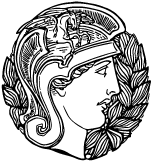
Title: [right] Cicero, plaster cast, ca. 1840
After antique marble, ca. 40-30 BC
Uffizi Gallery, Florence
Title: [left] Bust of a Man (possibly Lysimachus, Aratus, or Demosthenes), plaster cast, ca. 1840
After antique marble, ca. 100-80 BC
Naples National Archaeological Museum
For decades, two stained and forlorn classical plaster casts were hidden in a dark corner of the Art Room (pictured above before restoration). Perched on top of the bookcases, they were barely noticeable among the historic oil paintings and decorative folios. As part of the Curating Curiosities senior seminar class with Tripp Evans, a Wheaton College student was tasked with researching these two mysterious busts. The students scoured the collections for clues about the identity and provenance of the statuary, and an old scrapbook in the Archives revealed that they might be connected to one of the Athenæum’s earliest art donations.
In 1840, James Phalen gifted “ten well-executed busts of illustrious personages, ancient and modern” including Byron, Cicero, Demosthenes, Homer, Milton, Napoleon, Scott, Shakespeare, Socrates, and Washington. Today, only eight of these statues are represented among the busts displayed around the main hall, the remaining two – Cicero and Napoleon – are unaccounted for. As we continued our research of the two nameless busts, and explored the possibility that they might have a connection to Phalen’s missing Cicero and Napoleon, the busts were sent to Giust Gallery for restoration. While at Giust, the curator consulted the Catalogue of Caproni Casts (Boston, 1911) and revealed the busts identities as Cicero and Aratus, cast from originals in Italian museums.
This exciting discovery confirmed our suspicions that Cicero, one of Rome’s greatest orators, was most likely the missing Phalen bust of 1840, made from an original in the Uffizi Gallery, Florence. The cast identified by the Caproni brothers as “Aratus, Naples Museum,” however, has continued to be a conundrum. The Archives contain no records that support the Athenæum as having ever owned a portrait of the Greek poet Aratus, or any clues as to what became of the bust recorded as Napoleon. Could the cast identified as Napoleon in Phalen’s original documentation from 1840 actually have been Aratus? Or is there another possible explanation?
During the summer, we picked up the thread from the Caproni catalogue and started to research sculptures of Aratus in the Naples National Archaeological Museum. What we found was even more perplexing and led to more questions instead of answers. In the Naples museum, the current accession record lists the antique marble as busto maschile (Male Torso), but notes that it could possibly be Lysimachus, the Macedonian general and successor of Alexander the Great. In addition, there are copies of the bust in marble, lead, and plaster in museums around the globe, but each is listed by a different name, including Aratus, Lysimachus, Demosthenes (the Greek statesman and orator), a Roman General and simply, Bust of a Man.
While the Athenæum cannot definitively identify the history and provenance of the plaster casts without further scholarship, we believe these two busts were part of the Phalen gift. For now, they will be known as Cicero, after antique marble, Uffizi Gallery, and Bust of a Man (Possibly Lysimachus, Aratus, or Demosthenes), after antique marble, Naples National Archaeological Museum. Fully restored, the magnificent classical casts are prominently displayed at the library for all to admire and contemplate.
Discovered by: Tripp Evans, Mary L. Heuser Chair of Art History, Wheaton College; Giust Gallery; Stephanie Knott, Reference Librarian & Special Collections Assistant, Providence Athenæum; Michael Williams, student, Wheaton College; Kate Wodehouse, Director of Special Collections & Library Services, Providence Athenæum.



